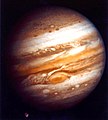Fasciculus:Jupiter gany.jpg

Mensura huius perspectionis: 538 × 600 elementa imaginalia. Aliae mensurae: 215 × 240 elementa imaginalia | 431 × 480 elementa imaginalia | 673 × 750 elementa imaginalia.
Sua resolutio (673 × 750 elementa imaginalia, magnitudo fasciculi: 114 chiliocteti, typus MIME: image/jpeg)
Historia fasciculi
Presso die vel tempore fasciculum videbis, sicut tunc temporis apparuit.
| Dies/Tempus | Minutio | Dimensiones | Usor | Sententia | |
|---|---|---|---|---|---|
| recentissima | 10:17, 15 Octobris 2023 |  | 673 × 750 (114 chiliocteti) | 0x0a | offcial JPG, more details |
| 08:19, 16 Februarii 2016 |  | 970 × 1 081 (281 chiliocteti) | PlanetUser | black bg | |
| 04:20, 15 Martii 2015 |  | 970 × 1 081 (72 chiliocteti) | Jcpag2012 | larger (with auto correction) from TIFF file | |
| 05:24, 22 Februarii 2015 |  | 758 × 858 (238 chiliocteti) | Jcpag2012 | processing | |
| 04:14, 9 Novembris 2004 |  | 758 × 858 (58 chiliocteti) | Gentgeen | {{PD-USGov-NASA}} |
Nexus ad fasciculum
Ad hunc fasciculum nectit:
Usus fasciculi per inceptus Vicimediorum
Quae incepta Vici fasciculo utuntur:
- Usus in af.wikipedia.org
- Usus in ar.wikipedia.org
- Usus in be.wikipedia.org
- Usus in bg.wikipedia.org
- Usus in cs.wikipedia.org
- Usus in en.wikipedia.org
- Usus in en.wiktionary.org
- Usus in es.wikipedia.org
- Usus in et.wikipedia.org
- Usus in eu.wikipedia.org
- Usus in fr.wikipedia.org
- Usus in gu.wikipedia.org
- Usus in he.wikipedia.org
- Usus in hi.wikipedia.org
- Usus in hr.wikipedia.org
- Usus in hr.wiktionary.org
- Usus in hy.wikipedia.org
- Usus in id.wikipedia.org
- Usus in it.wikipedia.org
- Usus in it.wiktionary.org
- Usus in ja.wikipedia.org
- Usus in ja.wiktionary.org
- Usus in kbp.wikipedia.org
- Usus in mdf.wikipedia.org
- Usus in mk.wikipedia.org
- Usus in ml.wikipedia.org
- Usus in mr.wikipedia.org
- Usus in mwl.wikipedia.org
- Usus in nl.wikipedia.org
- Usus in no.wikipedia.org
- Usus in pl.wikiquote.org
- Usus in ps.wikipedia.org
- Usus in pt.wikipedia.org
View more global usage of this file.



